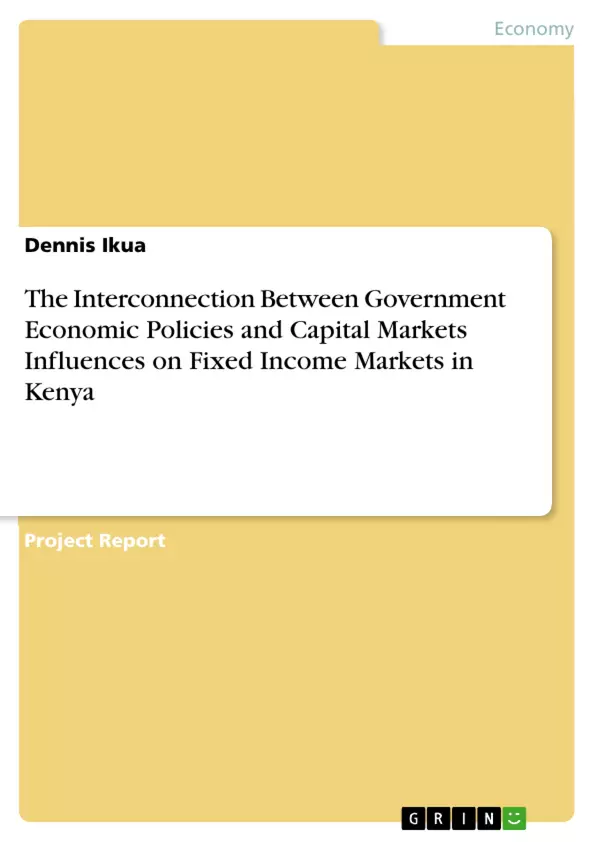The purpose of the study was to determine the effects of government economic policies and capital markets forces on fixed income markets in Kenya. The research was guided by three research questions were to determine the effects of fiscal policy on fixed income markets, to determine the effects of monetary policy on fixed income markets, and to determine the effects of capitals markets’ forces on fixed income markets.
The research was designed as an explanatory study with quantitative data that was collected from the official website of Central Bank of Kenya as well as from the website of Nairobi Securities Exchange. Data was collected for a period of five years beginning October 3, 2012 and ending on October 2, 2017. The data included the central bank rate, fiscal deficit, Kenya NSE Govt. Bond Index, and the computed spread between the market-weighted average rate (ask) and the weighted average of accepted bids (bid). Data analysis used multiple linear regression model, correlation analysis, and covariance analysis. Data analysis was conducted in Microsoft Excel using XLSTAT features.
Findings of the study on the effects of fiscal policy on fixed income markets indicate that fiscal deficits, and therefore the fiscal policies, had a weak correlation with the performance of fixed income markets. A weak correlation indicated that there was a limited extent to which fiscal policies can be used in explaining movements in the fixed income markets.
Monetary policy has a strong effect on the level of interest rates in the fixed income markets. The implications of this finding were that the monetary policy announcements, mainly announcements on central bank rate, can be used in predicting the direction of interest rates charged on treasury bills by the investors. However, the monetary policy announcements had a limited impact on the spread between the market-weighted average rate (ask) and the weighted average of accepted bids (bid) indicating the existence of a random walk in the determination of prices of Treasury bill instruments.
On effects of capitals markets’ forces on fixed income markets, FTSE NSE Kenya Govt. Bond Index has little to no impact on the interest rates charged on Treasury bill instruments in the primary market. The findings indicate that the performance of the FTSE NSE Kenya Govt. Bond Index would not be an accurate predictor of the level of interest rates for treasury instruments in Kenya.
Inhaltsverzeichnis (Table of Contents)
- DEDICATION
- ABSTRACT
- TABLE OF CONTENTS
- LIST OF TABLES
- LIST OF FIGURES
- LIST OF ACRONYMS AND ABBREVIATIONS
- CHAPTER ONE
- INTRODUCTION
- Background of the Study
- Statement of the Problem
- Purpose of the Study
- Research Questions
- Significance of the Study
- Scope of the Study
- Definition of Terms
- Chapter Summary
- CHAPTER TWO
- LITERATURE REVIEW
- Introduction
- Effects of Fiscal Policy on Fixed Income Markets
- Effects of Monetary Policy on Fixed Income Markets
- Effects of Capitals Markets' Forces on Fixed Income
- Chapter Summary
- CHAPTER THREE
- RESEARCH METHODOLOGY
- Introduction
- Research Design
Zielsetzung und Themenschwerpunkte (Objectives and Key Themes)
This research project aims to analyze the impact of government economic policies, specifically fiscal and monetary policies, and capital market forces on the fixed income markets in Kenya. The study uses quantitative data collected over a five-year period to assess the relationship between these factors and interest rate movements in the Treasury bill market.
- The influence of fiscal policy on fixed income markets.
- The impact of monetary policy on interest rates in fixed income markets.
- The role of capital market forces in shaping fixed income market performance.
- The predictive power of these factors in determining interest rate trends.
- Recommendations for policy interventions and investor strategies.
Zusammenfassung der Kapitel (Chapter Summaries)
Chapter One introduces the study's background, problem statement, purpose, research questions, significance, scope, and definition of key terms. It lays out the foundation for the research project and highlights the relevance of the study within the context of Kenya's economic landscape.
Chapter Two delves into the existing literature on the relationship between government economic policies and capital market forces on fixed income markets. It reviews various studies and theoretical frameworks to provide a comprehensive understanding of the subject matter.
Chapter Three outlines the research methodology employed in the study, including the research design, data collection methods, and data analysis techniques used to examine the research questions.
Schlüsselwörter (Keywords)
The research focuses on the interconnectedness of government economic policies, capital market forces, and fixed income market performance in Kenya. Key terms and concepts include fiscal policy, monetary policy, fixed income markets, interest rates, Treasury bills, capital markets, and the Kenyan economy.
- Quote paper
- Dennis Ikua (Author), 2019, The Interconnection Between Government Economic Policies and Capital Markets Influences on Fixed Income Markets in Kenya, Munich, GRIN Verlag, https://www.grin.com/document/496613



